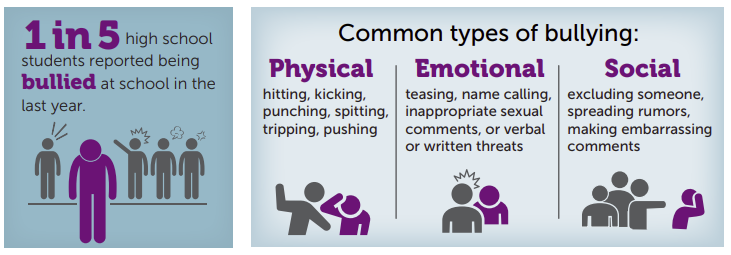Bullying is unwanted, aggressive behavior among school aged children that involves a real or perceived power imbalance. The behavior is repeated, or has the potential to be repeated, over time. Bullying can be physical, emotional, sexual, verbal, cyber-bullying and even by way of exclusion. The consequences of bullying can be serious, continue throughout the lifespan and affect not only children who are bullied and children who bully, but also their families and friends.

A study, Bullying Perpetration and Subsequent Sexual Violence Perpetration Among Middle School Students, found that bullying perpetration is associated with sexual harassment perpetration among middle and high school students and bullying victimization is associated with sexual harassment victimization. Also, when students engage in homophobic teasing, sexual perpetration and harassment may develop as students develop opposite-sex attractions.
Prevention is Possible
The good news is that bullying is preventable. The Centers for Disease Control and Prevention's Resources for Action are a select group of strategies based on the best available evidence that can be used to prevent public health problems such as violence. The strategies are intended to impact individual behaviors as well as the relationship, family, school, community, and societal factors that influence risk and protective factors for violence.
Shared Risk and Protective Factors
Bullying and sexual assault have shared risk and protective factors. Risk Factors are things that make it more likely that people will experience violence. Protective Factors are things that make it less likely that people will experience violence or that increase their resilience when they are faced with risk factors.
Connecting the Dots: An Overview of the Links Among Multiple Forms of Violence explains how coordinating prevention efforts that recognizes shared risk and protective factors can make a greater impact.
| Type of Violence Perpetration | |||
| Risk or Protective Factor | Intimate Partner Violence | Sexual Violence | Bullying |
| Media Violence | X | X | |
| Harmful norms around masculinity and femininity | X | X | X |
| Social Isolation | X | X | |
| Poor parent-child relationships | X | X | X |
| History of violence victimization | X | X | X |
| Substance Use | X | X | X |
| Connection/commitment to school | X | X | |
| Suggested anti-bullying programs for sexual violence prevention | |
| Sources of Strength | Sources of Strength is best practice youth suicide prevention project designed to harness the power of peer social networks to change unhealthy norms and culture, ultimately preventing suicide, bullying, and substance abuse. Sources of Strength moves beyond a singular focus on risk factors by utilizing an upstream approach for youth suicide prevention. Because Sources of Strength has demonstrated impact on school connectedness (protective factor for sexual violence), Colorado is piloting and evaluating as a sexual violence prevention strategy. |
| Shifting Boundaries | Shifting Boundaries is a two-part intervention—classroom curricula and schoolwide—designed to reduce dating violence and sexual harassment among middle school students by highlighting the consequences of this behavior for perpetrators and by increasing faculty surveillance of unsafe areas within the school. |
| Second Steps | Second Steps is a program rooted in social-emotional learning (SEL) that helps transform schools into supportive, successful learning environments uniquely equipped to encourage children to thrive. Second Step’s holistic approach helps create a more empathetic society by providing education professionals, families, and the larger community with tools to enable them to take an active role in the social-emotional growth and safety of today’s children. |
| Olweus | The Olweus Program (pronounced Ol-VAY-us) is a comprehensive approach that includes schoolwide, classroom, individual, and community components. The program is focused on long-term change that creates a safe and positive school climate. It is designed and evaluated for use in elementary, middle, junior high and high schools (K-12). The program’s goals are to reduce and prevent bullying problems among schoolchildren and to improve peer relations at school. |
| Bully Busters | The Bully Busters approach is research based and emphasizes both control and prevention. It helps teachers increase their awareness, knowledge base, and intervention skills to attack the root causes of bullying behavior and to deal with the problem confidently. The manual is organized into eight learning modules an each module includes a teacher information component and a series of classroom activities. The 36 activities are designed to increase student participation in reducing and preventing bullying, as well as to strengthen the teacher/student relationship. |
